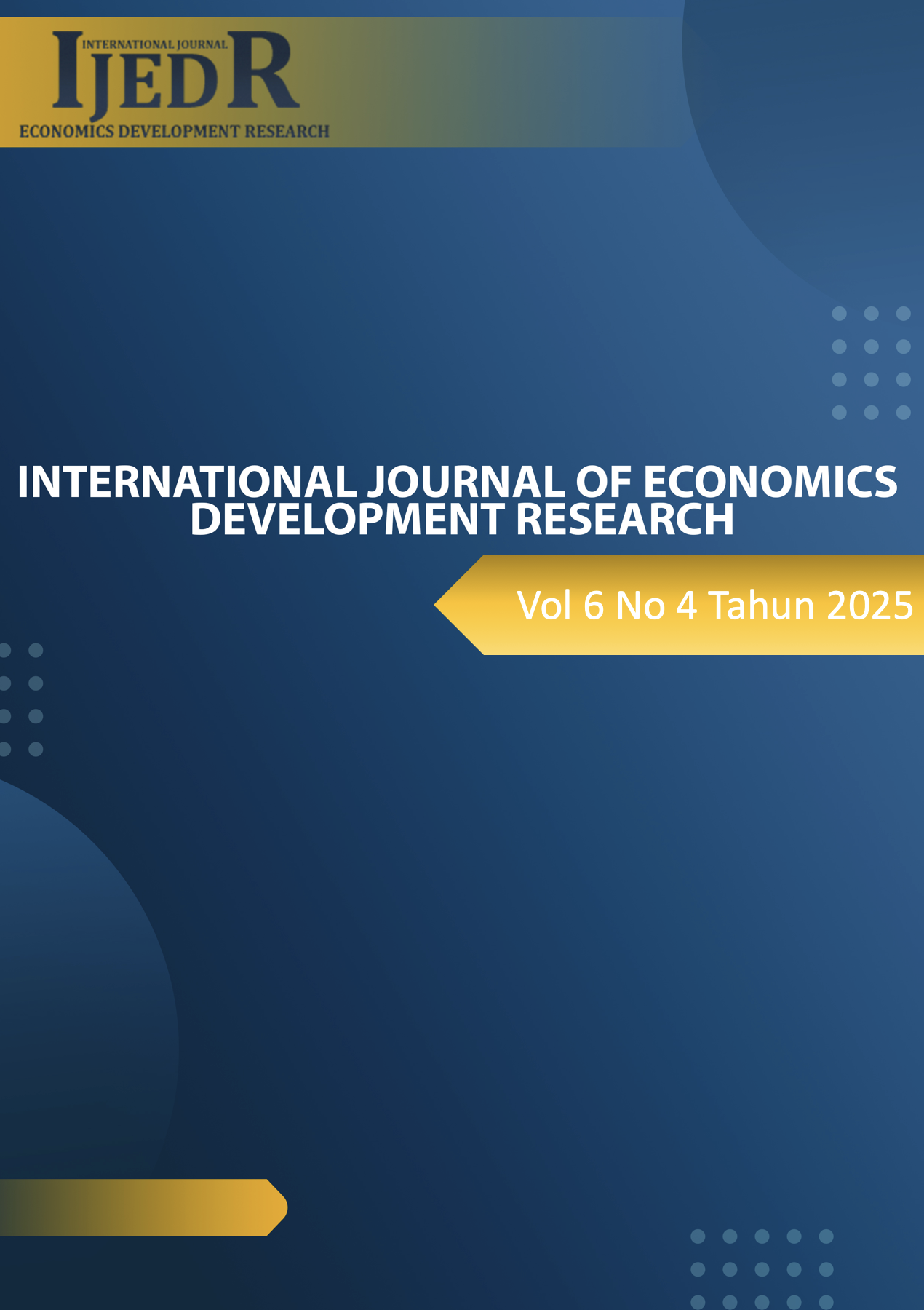Determining the Trade Value of Indonesian Lobster Exports to Destination Countries in 2018–2023
DOI:
https://doi.org/10.37385/ijedr.v6i5.8811Keywords:
trade value, price, export value, economic distanceAbstract
Indonesia has a very wide water area, making it one of the countries with great potential in developing the fisheries industry, especially in leading commodities such as lobster. This study was conducted to examine various factors that impact the value of Indonesian lobster exports to six major trading partner countries, namely China, Hong Kong, Japan, Singapore, Malaysia, and South Korea throughout 2018 to 2023. This study uses several independent variables including lobster prices, consumption tastes (Ratio), GDP per capita of destination countries, export value (FOB), export quantity, and economic distance. This study uses a quantitative approach by utilizing secondary data in the form of panel data, consisting of a time series from 2018 to 2023 and cross-country data for six export destination countries. Information was obtained from official sources such as BPS, Trade Economic, World Bank, and the Ministry of Marine Affairs and Fisheries (KKP). Based on the results of the analysis, the Common Effect Model (CEM) approach was identified as the most appropriate model in this study compared to other approaches. The results of the F test show that all independent variables have a significant influence on the value of Indonesian lobster exports, both simultaneously and partially. The determination value (R²) of 65.94% indicates that the regression model is able to explain most of the variation in the value of lobster export trade. The results of this study play a significant role in supporting the formulation of policies to increase the competitiveness of Indonesian fishery exports in the international market.
References
Adiputra, Y. T., et al. (2024). Caught in the net: Unravelling policy challenges and smuggling dynamics in Indonesia’s puerulus exploitation. Marine Policy, 169, 106336. https://doi.org/10.1016/j.marpol.2024.106336
Adiyanto, J. (2020). Arsitektur dan air (Kasus: Kota Palembang). ATRIUM Jurnal Arsitektur, 3(2), 85–99. https://doi.org/10.21460/atrium.v3i2.14
Azmi, T. M., Dawood, T. C., & Sartiyah, S. (2024). Determining the export competitiveness of Indonesian lobsters to major destination countries. International Journal of Finance, Economics and Business, 3(3), 151–162. https://doi.org/10.56225/ijfeb.v3i3.331
Benny, J. (2013). Ekspor dan impor pengaruhnya terhadap posisi cadangan devisa di Indonesia. Jurnal EMBA, 1(4), 1406–1415.
Boesono, H., Anggoro, S., & Bambang, A. N. (2011). Laju tangkap dan analisis usaha penangkapan lobster (Panulirus sp) dengan jaring lobster (gillnet monofilament) di perairan Kabupaten Kebumen. Jurnal Saintek Perikanan, 7(1), 77–87. https://doi.org/10.14710/ijfst.7.1.77-87
Carbaugh, B. (2016). College textbook publishing: Three microeconomic applications. The American Economist, 61(2), 191–203.
Gea, S., Widayatsari, A., & Darmayuda, D. (n.d.). Analisis daya saing dan dampak kebijakan pemerintah terhadap ekspor lobster Indonesia ke negara tujuan utama. Jurnal Ekonomi Pembangunan dan Pariwisata (JEPP), 3(1). https://doi.org/10.52300/jepp.v3i1.7540
Krugman, P. R. (2008). International economics: Theory and policy (8th ed.). Pearson Education India.
Kumar, V., & Patil, A. (2022). Consumer behavior towards seafood substitutes: An analysis of market trends. Food Research International, 147, Article 110492. https://doi.org/10.1016/j.foodres.2021.110492
Maghfirah, R. (2024). Pengaruh nilai tukar dan inflasi terhadap ekspor komoditas buah-buahan di Indonesia. Jurnal Ekonomi Pertanian Unimal, 7(2), 29–41. https://doi.org/10.29103/jepu.v7i2.18058
Maskun, Ilmar, A., Napang, M., Naswar, A., Achmad, & Assidiq, H. (2020). Legal analysis of lobster export policies in Indonesia: The principle of sustainable development approach. IOP Conference Series: Earth and Environmental Science, 564(1), 012067. https://doi.org/10.1088/1755-1315/564/1/012067
Metzgar, M. (2023). Revised Bloom’s taxonomy in a principles of Economics textbook. Acta Educationis Generalis, 13(3), 15–28. https://doi.org/10.2478/atd-2023-0019
Muzayyin, Y., Masyhuri, N. A., Darwanto, D. H., & Junaidi, E. (2019). Competitiveness and protection policy: The case of Indonesian lobster exports to the Asian markets. International Journal of Trade and Global Markets, 12(3–4), 260–271. https://doi.org/10.1504/IJTGM.2019.101562
Oppier, H., Yudawisastra, H. G., Hanim, W., Solikin, A., Wahyunawati, S., Effendi, N. I., & Junaedi, I. W. R. (2021). Ekonomi mikro. CV. Azka Pustaka.
Purba, A. M., Cls, A., Utami, M., Saparianti, N., Sinar, T. B. M., & Adlina, H. (2023). Teori perdagangan internasional: Pemahaman konseptual dan implikasinya dalam konteks global. Madani: Jurnal Ilmiah Multidisiplin, 1(5), 938–945. https://doi.org/10.5281/zenodo.8061593
Puspasari, N. K., & Darmawan, A. (2017). Pengaruh ekspor dan nilai tukar perdagangan (term of trade) terhadap produk domestik bruto (PDB) Indonesia (Studi periode 2008–2016). Jurnal Administrasi Bisnis (JAB), 50(1), 190–199.
Ricardo, D. (1821). On the principles of political economy. J. Murray.
Rizkillah, H. (2021). Analisis faktor-faktor yang memengaruhi volume ekspor lobster konsumsi Indonesia ke Singapura periode 2000–2018. Repository UIN Syarif Hidayatullah Jakarta.
Rossa, S., Wimasari, S. G. T. V., Rahmawati, S., & Thomas, T. A. (2021). Kegagalan pasar di balik ekspor benih lobster di Indonesia. Jurnal PolGov. https://doi.org/10.22146/polgov.v3i1.2195
Salvatore, D. (2019). International economics. John Wiley & Sons.
Saria, M. (2022). Implementasi kebijakan larangan ekspor benih bening lobster sesuai dengan Permen-KP No 17 Tahun 2021 di Pantai Popoh Kecamatan Besuki Kabupaten Tulungagung. JFMR-Journal of Fisheries and Marine Research, 6(3). https://doi.org/10.21776/ub.jfmr.2022.006.03.8
Siregar, H. P., Rizal, A., Hamdani, H., & Gumilar, I. (2020). The contribution of fisheries sector in regional development of Batam City of Riau Islands Province, Indonesia. Asian Journal of Fisheries and Aquatic Research, 7(3), 13–23.
Susanti, E. N., Oktaviani, R., Hartoyo, S., & Priyarsono, D. S. (2017). Efisiensi teknis usaha pembesaran lobster di Pulau Lombok, Nusa Tenggara Barat. Jurnal Manajemen dan Agribisnis, 14(3), 230–239. https://doi.org/10.17358/jma.14.3.230
Sutinah, M., Hamzah, M., Adhawati, S. S., Cangara, A., Wardani, E. K., & Mas’ud, A. (2025). Analyzing the competitiveness of Indonesia’s lobster exports: Comparative and competitive advantages using RCA and ECI indices. International Journal of Religion, 6(1), 77–87. https://doi.org/10.61707/22r9rn67
Tambunan, T. T. H. (2012). Peran usaha mikro dan kecil dalam pengentasan kemiskinan di daerah. Jurnal Bina Praja, 4(2), 73–92. https://doi.org/10.21787/jbp.04.2012.73-92





